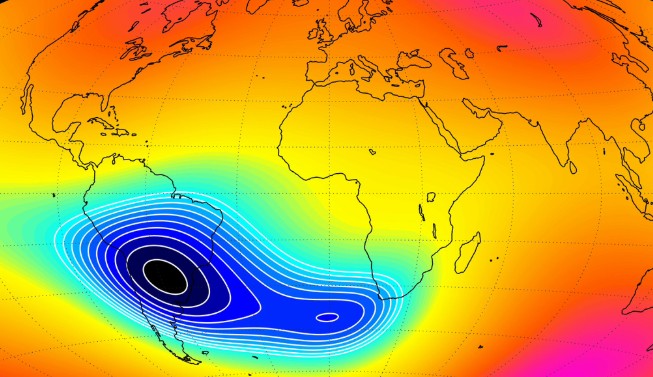The Earth’s glamorous field is like an unnoticeable guard, guarding us from dangerous cosmic and solar radiation. But over the South Atlantic, this guard is showing unusual weakness.
Known as the South Atlantic Anomaly (SAA), this mysterious patch of weakened magnetism is growing, and scientists advise it could affect satellites, technology, and indeed wildlife.
What is the Anomaly?
Scientists are growing increasingly concerned about a strange miracle stretching between South America and Africa.
The anomaly isn’t new; it was first detected in the mid-20th century, but recent studies show that it’s expanding in size and losing strength.
According to data from the European Space Agency’s Swarm satellite charge, launched in 2013, the SAA now covers an area roughly half the size of Europe.
Causes of the Anomaly
Earth’s magnetic field is generated by the movement of molten iron deep in the outer core. Normally stable, this field has fluctuated and even reversed throughout Earth’s history.
Chris Finlay, a researcher at the Technical University of Denmark and part of the Swarm team, told Science Alert: “We would normally expect to see magnetic field lines coming out of the core in the southern hemisphere.
But under the South Atlantic Anomaly, we see unexpected areas where the magnetic field, instead of coming out of the core, is coming back into it.”
These “reverse flow patches” at the boundary of the outer core and mantle are still not fully understood.
Risks for Satellites
While a full magnetic reversal wouldn’t end life on Earth, the weakening field has real consequences. Satellites passing through the SAA face advanced radiation, risking electronic damage and shorter dates.
There could also be goods on migrant catcalls, GPS systems, dispatches, and indeed electricity grids. The anomaly is uneven, with African and South American sectors carrying elsewhere, and the entire area is sluggishly shifting.
Finlay noted: “Something special is happening in this region that is causing a more intense weakening of the field.”
Monitoring the SAA is essential for understanding this glamorous irregularity and prognosticating its implicit impacts.
The European Space Agency’s mass satellites give high-resolution data, allowing scientists to track changes in the glamorous field over time and anticipate technological and environmental pitfalls.
Effects on Wildlife
Beyond technology, the South Atlantic Anomaly could impact natural systems. catcalls, marine creatures, and other species that rely on geomagnetic cues for migration may witness navigation difficulties.
This highlights the far-reaching consequences of geomagnetic decay, showing that indeed unnoticeable forces like Earth’s glamorous field play a vital part in life on our Earth.
Why the South Atlantic Anomaly Matters?
The South Atlantic Anomaly highlights how delicate and complex Earth’s inner processes are. Continued monitoring and exploration are pivotal to understanding this miracle, safeguarding satellites, and covering ecosystems.
In short, the SAA reminds us that our Earth’s glamorous field isn’t just a scientific curiosity, it’s an abecedarian guard that makes life as we know it possible.






